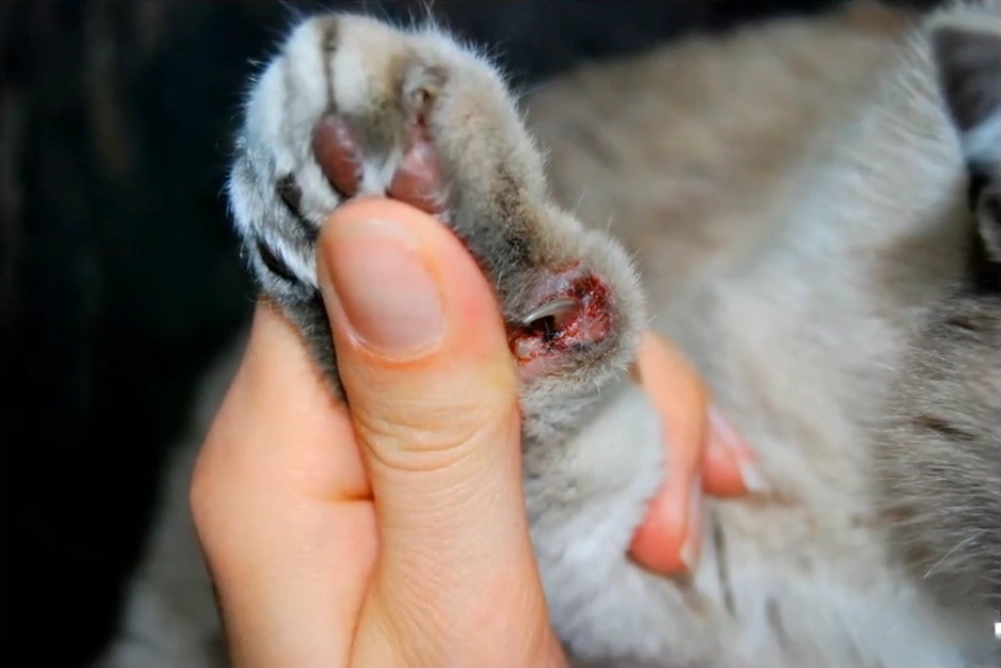Split Claws in Cats: Understanding Causes and Treatment Options
By: Elizabeth Rikas

The information in this article is intended to educate cat parents and is not a substitute for veterinary guidance. In case of any concerns about your cat’s health, please talk with your veterinarian.
Split claws in cats can be a concerning issue for pet owners. When a cat’s nail splits, it often indicates a lack of moisture or can be the result of improper nail growth. Recognizing the signs and understanding the causes will help owners take quick action to prevent pain and further complications for their feline friends.
Cats use their claws for various activities, such as climbing and scratching, which puts a lot of stress on their nails. If a split claw occurs, it may expose sensitive areas and lead to discomfort or infection. It’s essential for cat owners to be aware of how to treat this condition and know when to seek veterinary care for their pets.
By addressing split claws promptly, owners can ensure their cats stay healthy and happy. Preventive measures are also key to reducing future problems with nail splitting, keeping a cat’s paws in good condition.
Key Takeaways:
- Split claws can indicate moisture issues or nail growth problems.
- Quick action can help prevent infection or further discomfort.
- Regular maintenance can reduce the risk of split nails in cats.
Click to explore: Siberian Cat Size Comparison
Understanding Split Claws in Cats
Split claws are a common issue in cats that can lead to discomfort and potential health problems. Knowing the causes, signs, and prevention strategies is crucial for cat owners.
Causes of Split Claws
Split claws can occur for several reasons. A significant cause is improper nail trimming. If a cat’s claws are not trimmed regularly, they may grow too long. This can create uneven pressure, leading to splits.
Natural wear and tear also play a role, especially for active cats who scratch surfaces. Additionally, aging cats may experience more splitting due to weakened nails. Health issues like nutritional deficiencies and medical conditions can contribute as well. If a veterinarian suspects a health problem, they may recommend blood tests.
Signs and Symptoms
Owners should be aware of common signs of split claws. These may include visible cracks or splits in the nail. A cat may also show signs of discomfort, such as limping or avoiding scratching.
Behavioral changes can also indicate pain. If a cat is less active or hesitant to engage in play, it may be due to painful claws. Owners should check for any bleeding or pus around the claw area, which could signal infection. Regular inspections of the claws can help catch issues early. If any concerning signs are noted, a visit to the veterinarian is advised.
Prevention Strategies
Preventing split claws involves regular care and monitoring. Regular nail trimming, ideally every few weeks, is essential. This keeps the claws at a healthy length and reduces the chance of splits.
Providing scratching posts can help cats maintain healthy claws naturally. Owners should ensure that these posts are made from appropriate materials and are sturdy enough for their cat.
Feeding a balanced diet is also crucial for healthy nails. Cats need proper nutrients for strong claws. Lastly, regular vet check-ups can help identify any underlying health issues that affect claw health.
Immediate Actions and First Aid
When a cat has a split claw, prompt care is crucial to prevent further injury and infection. The following steps include effective home remedies and tips on when to seek professional help.
Home Remedies
First, the individual should assess the damage. If the split claw is bleeding, applying pressure with a clean cloth can help control it. If the bleeding persists, using cornstarch can be helpful. It acts as a natural coagulant.
To minimize discomfort, keep the cat calm and restrict its movement. Cleaning the area gently with a mild antiseptic is essential to avoid infection. A cotton swab can be used to apply the antiseptic carefully around the claw without causing more pain.
Keeping the split claw protected can also help. Using a small bandage may provide a temporary shield. However, ensure it is not too tight, as that can restrict blood flow.
When to Consult a Veterinarian
If the split claw looks deep or the bleeding does not stop after a few minutes, a veterinarian’s visit is necessary. Signs of infection such as swelling, redness, or discharge indicate that professional treatment is required.
Additionally, if the cat shows signs of pain, such as excessive licking around the claw, limping, or reluctance to walk, veterinary care should be sought. Cats may also need prescription medication to manage pain or prevent infection.
Regular veterinary check-ups can help prevent issues with claws and overall health. Always err on the side of caution when it comes to a pet’s well-being.
Click to explore: Do cats actually eat mice?
Professional Veterinary Care
When a cat has a split claw, seeking professional veterinary care is essential. A veterinarian can accurately diagnose the issue and recommend the best treatment options. This section will explore how a veterinarian approaches diagnosis, the available treatment choices, and key points regarding recovery and aftercare.
Diagnosis by a Veterinarian
A veterinarian will start with a physical examination of the cat’s paw. They will check for signs of pain, swelling, or infection around the split claw.
The vet may take X-rays if they suspect a deeper issue, such as a broken bone or infection. Diagnosing underlying health conditions is also important since split claws can indicate problems with a cat’s overall health.
They might ask questions about the cat’s behavior and any recent incidents that could have caused the injury. Gathering this information helps the vet provide the best care possible.
Click to explore: When Do Kittens Calm Down
Treatment Options
Treatment depends on the severity of the split claw. For minor splits, a veterinarian might recommend trimming the affected claw carefully with nail clippers to prevent further injury.
If the claw is severely damaged or infected, surgery might be necessary. The veterinarian would remove the damaged portion and offer medication to ease pain and prevent infection.
In some cases, a vet may use a bandage to protect the claw during healing. Keeping the bandaged area clean and dry is crucial.
The vet will provide guidance on when to return for a follow-up visit to monitor recovery.
Recovery and Aftercare
After treatment, monitoring the cat’s behavior is important. Owners should watch for signs of pain or excessive licking of the paw.
The veterinarian may provide specific aftercare instructions to support healing. This can include applying topical ointments, keeping the cat’s environment clean, and preventing outdoor access to avoid further injury.
If the cat received surgery, limit their activity for a few days as they recover. Regular follow-ups with the veterinarian are essential to ensure the claw heals properly.
With proper care and attention, most cats recover from split claws without long-term issues.
Frequently Asked Questions
This section addresses common concerns about split claws in cats. It provides specific information about treatment options, when to see a vet, prevention tips, and what to do in case of bleeding.
Conclusion
Split claws in cats are a common yet manageable issue that can cause discomfort if left untreated. By understanding the causes—such as improper nail growth, lack of moisture, or underlying health issues—cat owners can take proactive steps to prevent and address this condition. Regular nail trimming, providing scratching posts, and ensuring a balanced diet are key to maintaining healthy claws and avoiding complications.
Prompt action is essential when a split claw occurs to prevent pain, infection, or further damage. Home remedies like gentle cleaning and applying antiseptics can help, but veterinary care is crucial for severe cases. With proper care and preventive measures, cat owners can ensure their feline companions remain active, comfortable, and free from claw-related issues.

About the Author
Elizabeth Rikas
Elizabeth is a passionate advocate for feline health and well-being, drawing from her years as a dedicated pet parent to three cats—Gypsy, Swan, and Alfred—and her invaluable experience volunteering at animal shelters. A seasoned writer with a lifelong love for cats, Elizabeth began sharing her insights in her teens and has since contributed extensively to platforms focused on feline care. Through her expertise and heartfelt dedication, she empowers pet owners with practical advice and research-backed knowledge to nurture their furry companions.
